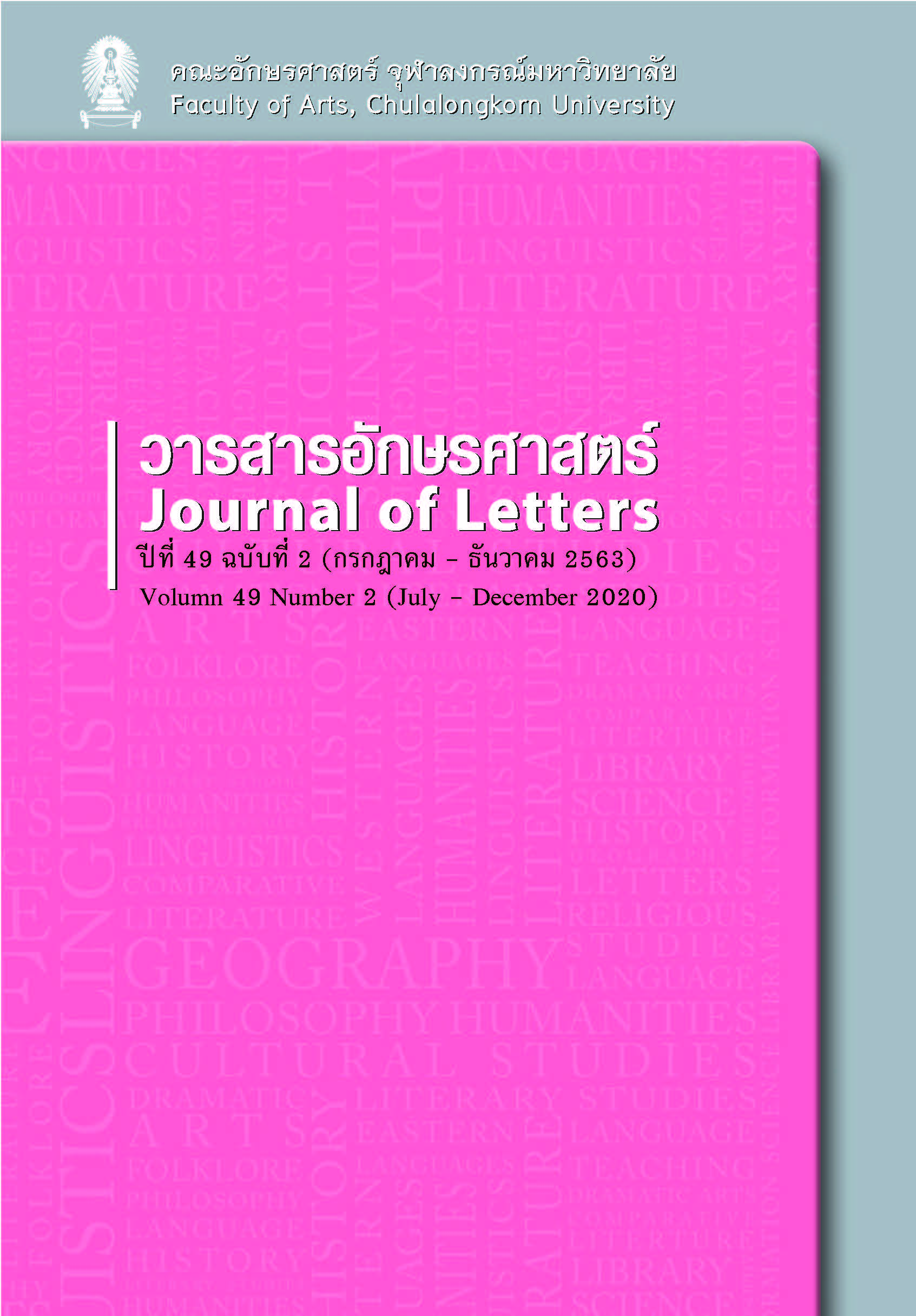การสื่อความหมายของหน่วยสร้างกริยาเรียงภาษาไทยเป็นภาษาอังกฤษ:
กรณีศึกษา รวมเรื่องสั้น กลิ่นฟาง
คำสำคัญ:
การแปล, หน่วยสร้างกริยาเรียงแสดงเหตุการณ์ที่เกิดขึ้นพร้อมกัน, การแปลแบบตีความ, แนวคิดการคิดเพื่อที่จะพูด, แนวคิดซีนแอนด์เฟรมซีแมนติกส์บทคัดย่อ
งานวิจัยนี้มีวัตถุประสงค์เพื่อศึกษาการสื่อความหมายของหน่วยสร้างกริยาเรียงที่แสดงสองเหตุการณ์ที่เกิดขึ้นพร้อมกันแบบซ้อนทับกันสนิทเป็นวัตถุวิสัยเดียวจากภาษาไทยเป็นภาษาอังกฤษ โดยใช้ข้อมูลจากหนังสือรวมเรื่องสั้น กลิ่นฟาง The Sweet Scent of Hay ซึ่งจัดเก็บในรูปคลังข้อมูลเทียบบทขนาด 64,879 คำ พบหน่วยสร้างกริยาเรียงแบบดังกล่าวซึ่งประกอบด้วยคำกริยา 2 คำจำนวนทั้งสิ้น 61 หน่วยสร้างโดยนับรวมหน่วยสร้างที่เกิดซ้ำด้วย เนื่องจากมีคำแปลที่ต่างกัน ผลการวิเคราะห์เชิงปริมาณสรุปได้ว่า บทแปลที่มีสมมูลภาพทางความหมายระหว่างภาษาต้นทางและภาษาปลายทางมีจำนวนทั้งสิ้น 50 หน่วยสร้าง หรือร้อยละ 81.97 และที่ไม่มีสมมูลภาพทางความหมายจำนวน 11 หน่วยสร้าง คิดเป็นร้อยละ 18.03 ในกรณีที่บทแปลมีสมมูลภาพทางความหมาย พบว่าผู้แปลใช้รูปแบบการแปลที่หลากหลาย รูปแบบที่พบมากและน่าสนใจคือ การใช้โครงสร้างกริยาวลีและการแปลโดยอาศัยบริบทเป็นตัวสื่อความ โดยเฉพาะข้อความที่ปรากฏก่อนหน้าหน่วยสร้างกริยาเรียง ในกรณีที่ไม่มีสมมูลภาพทางความหมาย ผู้แปลจะใช้วิธีละคำกริยาคำใดคำหนึ่งมากที่สุด ผลการวิเคราะห์เชิงคุณภาพสรุปได้ว่า กลวิธีหลากหลายที่ใช้ในการสื่อความหมายหน่วยสร้างกริยาเรียงที่แสดงเหตุการณ์สองเหตุการณ์ที่เกิดพร้อมกันจากภาษาไทยเป็นภาษาอังกฤษที่สละสลวยเป็นธรรมชาตินั้นสามารถนำแนวทางการแปลแบบตีความ (Interpretive Approach) แนวคิดการคิดเพื่อที่จะพูด (Thinking for Speaking) และแนวคิดซีนแอนด์เฟรมซีแมนติกส์ (Scenes-and-Frames Semantics) มาอธิบายได้อย่างมีประสิทธิภาพ
เอกสารอ้างอิง
ภาษาไทย
Amara Prasithrarthsint อมรา ประสิทธิ์รัฐสินธุ์. 2002. Khwam taektang thang khrongsang khong phasa Thai kap phasa Angkrit thi mi phon tor karn plae ความแตกต่างทางโครงสร้างของภาษาไทยกับภาษาอังกฤษที่มีผลต่อการแปล [Differences between Thai and English syntactic structures that affect translation]. Warasarn Ramkhamhaeng วารสารรามคำแหง [Ramkhamhaeng University Journal] 19(3): 68-82.
Charasdao Intratat จรัสดาว อินทรทัศน์. 1996. “Krabuankarn thi kham kriya klaipen kham bupphabot nai phasa Thai” กระบวนการที่คำกริยากลายเป็นคำบุพบทในภาษาไทย [Grammaticalization of verbs into prepositions in Thai]. Doctoral Dissertation, Chulalongkorn University.
Kanit Chinsin, & Prima Mallikamas กนิษฐ์ ฉินสินและปรีมา มัลลิกะมาส. 2017. Karn sueksa priapthiap konlawithi karn plae nuai sang kriya riang phasa Thai pen phasa Angkrit: korani sueksa rueang khanglang phap การศึกษาเปรียบเทียบกลวิธีการแปลหน่วยสร้างกริยาเรียงภาษาไทยเป็นภาษาอังกฤษ: กรณีศึกษา เรื่อง ข้างหลังภาพ [A comparative study of strategies for the translation of serial verb constructions in Thai into English: a case study of the novel Behind the Painting] Warasarn Karn Plae Lae Karn Lam วารสารการแปลและการล่าม [Journal of Translation and Interpretation Thailand] 2(1): 1-42.
Kingkarn Thepkanjana กิ่งกาญจน์ เทพกาญจนา. 2010. Nuai sang kriya riang tonbaep nai phasa Thai หน่วยสร้างกริยาเรียงต้นแบบในภาษาไทย [Prototypical serial verb constructions in Thai]. In Nuai sang thi mi khokhatyaeng nai waiyakorn Thai หน่วยสร้างที่มีข้อขัดแย้งในไวยากรณ์ไทย [Controversial Construction in Thai Grammar] (2nd ed.), ed. Amara Prasithrathsint, 66-173. Bangkok: Chulalongkorn University Press.
Kingkarn Thepkanjana กิ่งกาญจน์ เทพกาญจนา. 2016. krabuankarn klaipen rup waiyakorn กระบวนการกลายเป็นรูปไวยากรณ์ [Grammaticalization]. Bangkok: Research and publication division, Faculty of Arts, Chulalongkorn University.
Kritsana Asoksin กฤษณา อโศกสิน. 2006. Klinfang กลิ่นฟาง [The Sweet Scent of Hay] (Wasana Cholasueks Kenman, Trans.). Bangkok: Chulalongkorn University Press.
Lederer, Marianne เลเดแรร์, มารีอานน์. 1997. Karn plae khue karn thaithot khwammai michai karn thai phasa การแปลคือการถ่ายทอดความหมาย มิใช่การถ่ายภาษา [Translation is transfer of meaning not transcoding] (Jirapun Boonyakiat, Trans.). In Sat karn plae: ruam botkhwam choeng thruesadi lae patibat ศาสตร์การแปล: รวมบทความเชิงทฤษฎีและปฏิบัติ [Translation Studies: collection of articles on theory and practice], ed. Nopporn Prachakul, 1-43. Bangkok: Translation center program, Faculty of Liberal Arts, Thammasat University.
Methinee Singhavejsakul, & Prima Mallikamas เมทินี สิงห์เวชสกุลและปรีมา มัลลิกะมาส. 2014. Karn plae mano that thi sue doi nuai sang kriya riang thi mi kham wa “ao” chak phasa Thai pen phasa Angkrit: korani sueksa rueang lai chiwit. การแปลมโนทัศน์ที่สื่อโดยหน่วยสร้างกริยาเรียงที่มีคำว่า “เอา” จากภาษาไทยเป็นภาษาอังกฤษ: กรณีศึกษา เรื่อง หลายชีวิต [A study of conveying Thai serial verb constructions with the word /?au/ into English: a case study of Many Lives]. Warasarn nida phasa lae karn suesan วารสารนิด้าภาษาและการสื่อสาร [NIDA Journal of Language and Communication] 19(23): 38-62.
Punya Borisuth ปัญญา บริสุทธ์. 1999. Thritsadi lae withi patibat nai karn plae ทฤษฎีและวิธีปฏิบัติในการแปล [Theory and practice in translation]. Bangkok: The Royal Institute.
Somjit Jirananthiporn, & Prima Mallikamas สมจิต จิระนันทิพร และปรีมา มัลลิกะมาส. 2016. Panha karn plae nuai sang kriya riang phasa Thai pen phasa Angkrit khong phurian chao Thai ปัญหาการแปลหน่วยสร้างกริยาเรียงภาษาไทยเป็นภาษาอังกฤษของผู้เรียนชาวไทย [Thai learners’ problems in translating Thai serial verb constructions into English]. Warasan Aksorasart วารสารอักษรศาสตร์ [Journal of Letters] 45(2): 204-262.
Suphanee Pinmanee สุพรรณี ปิ่นมณี. 2012. Plae dai plae di แปลได้ แปลดี [Good and accurate translation] (3rd ed.). Bangkok: Chulalongkorn University Press.
Wanna Saengaramruang วรรณา แสงอร่ามเรือง. 2009. Thritsadi lae lakkarn plae ทฤษฎีและหลักการแปล [Translation theory and principle] (3rd ed.). Bangkok: Research and publication division, Faculty of Arts, Chulalongkorn University.
Yajai Chuvicha ยาใจ ชูวิชา. 1993. “Khwam pen prayok khong nuai sang kriya riang nai phasa Thai”
ความเป็นประโยคของหน่วยสร้างกริยาเรียงในภาษาไทย [Serial Verb, Clausehood, Construction]. Doctoral Dissertation, Chulalongkorn University.
ภาษาอังกฤษ
Aikhenvald, Alexandra Y. 2007. Serial Verb Construction in Typological Perspective. In Serial Verb Constructions: A Cross-linguistic Typology, Alexandra Y. Aikenvald, and R. M. W. Dixon, eds., 1-68 New York: Oxford University Press.
Bybee, J., Perkins, R., & Pagliuca, W. 1994. The Evolution of Grammar: Tense, Aspect, and Modality in the Language of the World. Chicago: The University of Chicago Press.
Delisle, Jean. 1988. Translation: An Interpretive Approach (P. Logan, & M. Creery, Trans.). Ottawa: University of Ottawa Press. (Original work published 1980).
Dixon, R. M. W. 2007. Serial Verb Constructions: Conspectus and Coda. In Serial Verb Constructions: A Cross-Linguistic Typology, Alexandra Y. Aikenvald, and R. M. W. Dixon, eds., 338-350. New York: Oxford University Press.
Iwasaki, S., & Ingkaphirom, P. 2009. A Reference Grammar of Thai. Cambridge: Cambridge University Press.
Kroeger, Paul R. 2004. Analyzing Syntax: A Lexical-Functional Approach. Cambridge: Cambridge University Press.
Levelt, Willem J. M. 1989. Speaking: From Intention to Articulation. Cambridge, MA: MIT Press.
Liswahyuningsih, Ni Luh Gede. 2011. “Indonesian V-V Constructions in ‘Laskar Pelangi’ and Their Translations in ‘The Rainbow Troops’”. Master Thesis, Udayana University, Denparsar. http://www.pps.unud.ac.id/thesis/pdf_thesis/unud-139-190662839-cover%20lis.pdf
Slobin, Dan I. 1987. Thinking for Speaking. In Proceedings of the Thirteenth Annual Meeting of the Berkeley Linguistics Society, Jon Aske, Natasha Beery, Laura Michaelis, and Hana Filip, eds., 435-445. Berkeley, California: Berkeley Linguistics Society.
Slobin, Dan I. 1996. From “Thought and Language” to “Thinking for Speaking”. In Rethinking Linguistic Relativity, John. J. Gumperz, and Stephen C. Levinson, eds., 70-96. Cambridge: Cambridge University Press.
Slobin, Dan I. 2003. Language and Thought Online: Cognitive Consequences of Linguistic Relativity. In Language in Mind: Advances in the Study of Language and Thought, Dedre Gentner, and Susan Glodin-Meadow, eds., 157-192. Cambridge, MA: MIT Press.
Sutthichatchawanwong, Wanlee. 2007. “A Study of the Translation of Thai Serial Verb Constructions with Directional Verbs and Their Semantic and Syntactic Equivalence in English.” Unpublished doctoral dissertation, Chulalongkorn University, Bangkok.
Talmy, Leonard. 1991. Path to Realization: A Typology of Event Conflation. In Proceedings of the Seventeenth Annual Meeting of the Berkeley Linguistics Society, Laurel A. Sutton, Christopher Johnson, and Ruth Shields, eds., 480-519. Berkeley, California: Berkeley Linguistics Society.
Wehmeier, S. (Ed.). 2010. Oxford Advanced Learner’s Dictionary of Current English (7th ed.). Oxford: Oxford University Press.
ดาวน์โหลด
เผยแพร่แล้ว
รูปแบบการอ้างอิง
ฉบับ
ประเภทบทความ
สัญญาอนุญาต
การป้องกันปัญหาด้านลิขสิทธิ์และการคัดลอกผลงาน
ผู้เขียนบทความมีหน้าที่ในการขออนุญาตใช้วัสดุที่มีลิขสิทธิ์คุ้มครองจากเจ้าของลิขสิทธิ์ ผู้เขียนบทความมีความรับผิดชอบที่จะต้องปฏิบัติตามกฎหมายในการคัดลอกและทำสำเนาวัสดุที่มีลิขสิทธิ์อย่างเคร่งครัด การคัดลอกข้อความและการกล่าวพาดพิงถึงเนื้อหาจากวัสดุตีพิมพ์อื่น ต้องมีการอ้างอิงแหล่งที่มากำกับและระบุแหล่งที่มาให้ชัดเจนในส่วนบรรณานุกรม การคัดลอกข้อความหรือเนื้อหาจากแหล่งอื่นโดยไม่มีการอ้างอิงถือเป็นการละเมิดจริยธรรมทางวิชาการที่ร้ายแรง และเข้าข่ายการละเมิดลิขสิทธิ์ตามพระราชบัญญัติลิขสิทธิ์ พ.ศ. 2537 หากมีการฟ้องร้องดำเนินคดีใด ๆ เกิดขึ้น ผู้เขียนบทความมีความรับผิดชอบทางกฎหมายแต่เพียงผู้เดียว



